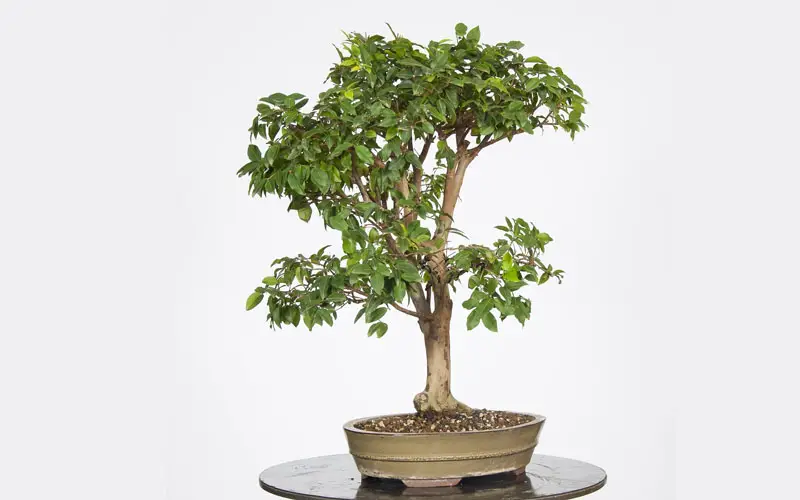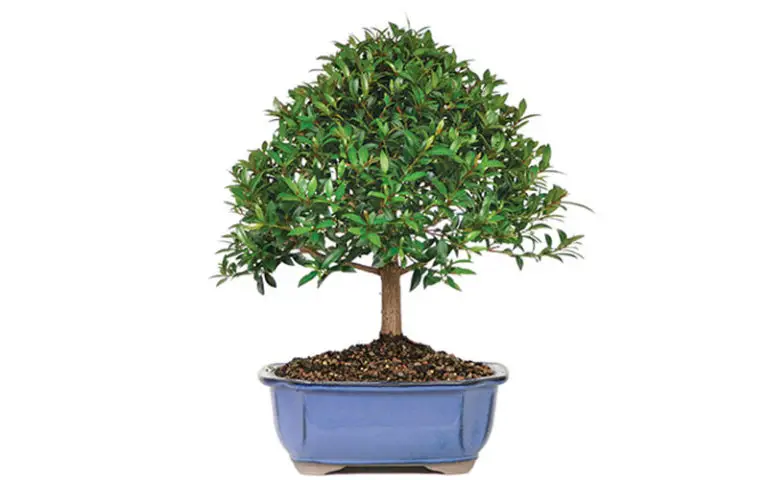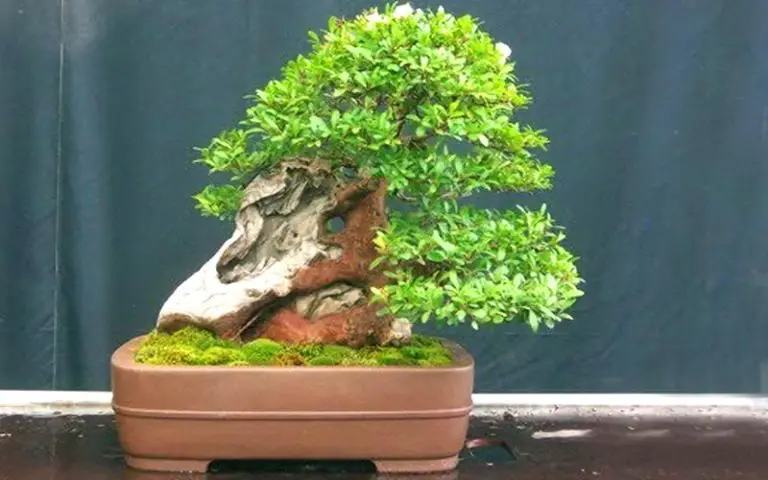Syzygium Bonsai | Care and Information Sheet

The Syzygium genus is an absolutely stunning collection of over 1200 species. With fruit that many people call rose apple, waterberry, or brush cherry, it has outstanding green, glossy leaves. The species are spread in various countries worldwide, but you can easily grow and maintain a Syzygium bonsai from seed or cutting.
In this care sheet, we’ll look at the following:
In this care sheet, we’ll look at the following:
Quick Syzygium Bonsai Care Sheet
Let’s begin with a brief TL;DR of how to care for a Syzygium bonsai. You can grab the essential facts in the table below, but we encourage you to read into the detailed article. We have loads of advice if it’s your first time with this genus.
Recommended soil
Standard mix with adequate drainage
Watering
Summer: daily; winter: when necessary
Potting season
Every two years in spring or autumn
Shaping and pruning season
Prune regularly during growing seasons
Light
Morning sunlight with dappled shade in the afternoon in extreme heat
Fertilizing
Spring to autumn: every two weeks; winter: once a month
Propagation methods
Seeds and cuttings
Pests and diseases
Mealy bugs, scales, fruit flies, spider mites, and aphids
Growth patterns
Vigorous growth that can quickly run out of control
Recommended styles
You can develop most styles, but be cautious with wiring
Native area
Various species are native to countries worldwide, with the bulk in Africa, Australia, and Asia
Scientific Classification
- Clade: Rosids
- Order: Myrtales (myrtle)
- Family: Myrtaceae (myrtle)
- Genus: Syzygium (brush cherry/rose apple)

How to Care for a Syzygium Bonsai
We’ve reached the vegetative meat of our care sheet. We’ll take you through each of the aspects mentioned in the table above so you can get a better idea of how to maintain a Syzygium bonsai. You should have no more concerns after reading this detailed guide.
Best Soil
The Syzygium bonsai isn’t too fussy when it comes to soil content. You can use a standard mix or try Azalea substrate like Kanuma. Either way, it’ll happily live in normal soil as long as there’s sufficient drainage and nutrients.
Watering
Since the Syzygium bonsai tree transfers most of the liquids to the berries, you can expect it to be incredibly thirsty. Other tree types generally slow down when autumn arrives, but not this genus. It’ll continue lapping up the water until winter, while still taking small amounts during dormancy.
While it loves having moist soil, it doesn’t like having its roots constantly wet. You should wait until the top 2 inches of soil is dry before commencing with the next watering. If it’s an incredibly hot summer, you might even have to water it twice a day to keep it satisfied.
Repotting
The best time to transplant a Syzygium bonsai is in early spring just as new life kicks in and before it grows too vigorously. You should perform this task twice a year, as the roots develop almost as quickly as the foliage. Take care not to damage any of the roots, soaking them for about half an hour before placing them in the new soil.
If you’re worried that you’ve missed the spring slot, you can also repot in autumn. Wait until just before winter dormancy kicks in, which is when it’s safer to move the roots. Try not to disturb the roots too much, but ensure that you remove as much of the old soil as possible.
Shaping and Pruning
You can design prune a Syzygium bonsai at any time, as the tree doesn’t mind cutting back at all. If you want to focus on the structure, you can perform design pruning in late autumn or winter. In this way, you won’t have to worry about constant new growth.
Spring and summer are slightly trickier to design prune. You’ll spend more time doing maintenance clipping, as the shoots and branches develop rapidly. We’re sure you’ll struggle to keep up at times, especially if you grow a bonsai forest, but regular trimming is necessary if you don’t want to lose the shape.
Location and Sunlight
It’s undeniable that the Syzygium bonsai loves as much sunlight as you can provide. You could place it outside in spring all day long, and it would be the happiest little tree you’ve ever seen. However, you’d do it a favor by bringing it indoors when it’s extremely hot.
When winter and frost arrive, it’s also a good idea to move the bonsai tree inside your house. If you live in an apartment, you could get away with placing it by a window for a few hours of the morning sun. Even if it only receives indirect light from the afternoon onwards, it’ll still have enough to produce food.
Fertilizing
As with water and sunlight, you’ll want to feed your Syzgium bonsai tree a lot. Start with every two weeks from spring into the heart of autumn. When winter arrives you can shift to once a month in order to ensure that there are enough nutrients running around inside.
Much like Azaleas, it loves acidic food. You can use liquid or solid fertilizer, or aim for a Nitrosol mix of 3:1:5. Remember to drown the soil with the mixture when it’s time to feed, especially when it’s incredibly hot, as it will want to feed as much as possible.
Propagation Methods
If you’re keen on growing a Syzygium bonsai from cuttings, you’ll be happy to know that it takes well under the right conditions. Aim for early spring when growth is vigorous, and try to take a large cutting if possible. In that way, you can start trimming and pruning by the end of the season.
While cuttings do work, we favor growing them from seed. They develop extremely fast, and you’ll have a youngling longer than your fingers before the end of the season. We’ve even seen them germinate during winter, as long as you grow it indoors where there’s plenty of sunlight.
Pests and Diseases
Unfortunately, the Syzygium bonsai is susceptible to attacks from diseases and pests. You’d think that it draws them in, which is likely the case when it comes to bearing fruit. Small fruit flies and other insects love to feed on the berries, which is why you should remove any ripe ones as soon as possible.
There are other pests that also cause problems, such as aphids, spider mites, scales, and mealy bugs. You can use any pesticide for them, but we find that Rosecare performs pretty well. We guess that makes sense when you consider that the Syzygium falls in the same Order classification as roses.
Growth Patterns
If it wasn’t already abundantly clear from this guide already, the bonsai tree grows rapidly with new shoots, flowers, and berries. Even as a sapling, it springs tall and wide quickly. You’ll need to constantly maintain it if you want to retain the shape you want.
Recommended Styles
You can style this any Syzygym species as you want, as it can quite comfortably shape it as you please. The only concern is with bending and wiring due to the thin, fragile branches. You might want to twist it slightly when bending to avoid any breakage. It doesn’t handle massive scars well, either.

Considerations for Growing an Indoor Syzygium Bonsai
Now that you’ve seen how to care for a Syzygium bonsai, it’s time to analyze what to consider when growing one inside your home. These tips are helpful if you’re a beginner, but you might also learn something if you’re an expert.
Transporting from a Different Region
While the Syzygium grows fast and well, it doesn’t like extreme changes in temperature or climate. It might take a while for it to adjust, so don’t be afraid if you see some leaves falling. After some time, you’ll see new shoots developing if you continue to provide sufficient light and water.
Check the Species
As we’ve indicated, there are over 1200 species in the Syzygium genus. There are some that are native to and perform well in specific countries. They may also have unique requirements not indicated in our general guide. Do yourself a favor and look up the care sheet for the species you have.
Training Techniques
There are so many ideas you can play with when it comes to the Syzygium bonsai tree. However, you need to train it from a youngling or as early as possible to achieve the desired outcome. Don’t be afraid to ask for some expert advice (you can email us too) to help you along.
Common Issues When Caring for a Syzygium Bonsai
If you’ve obtained a new Syzygium bonsai, you may experience a few common issues. We’ll list them here below and indicate what could be the possible cause. You don’t need to worry, as many of us have gone through the same problems.
- Infestations: This genus is prone to pests and diseases, especially when flowering and growing seeds. It’s best to spray pesticides when you see issues like aphids or spider mites as soon as possible.
- Drying/falling leaves: If the bonsai was shipped to you, you need to let it go through a transition period. The change of climate has made it unhappy, and it will grow new shoots after dropping the old ones. If you’ve had the bonsai for a while, ensure you aren’t underwatering.
- Snapping branches when shaping: The branches are fragile and can easily break. It’s best to slightly twist it when using wires to form it into shape. Ensure you water the soil beforehand to make it more pliable.
- Root rot: If you’re letting the roots lay in water for too long, it will start to rot and kill the tree. You should only apply water when the soil is dry.
Interesting Facts About Syzygium Bonsai
Before you leave, we want to leave you with some interesting food for thought. We’ve collected some of these facts online, while we’re more familiar with others from our years of experience with this wonderful tree.
- Australia has 52 species of Syzygium, and they tend to call them brush cherries, lillipillies, or satinash;
- Syzygium was once confused with a similar genus, Eugenia, which contains about 1000 species. You might still see some sites refer to the brush cherries as Eugenia, but it’s taxonomically incorrect.
- The fruit are edible with a delicious, sweet taste. Each one contains only a single seed, which you can easily propagate.

FAQ About Syzygium Bonsai
Now that we’ve shown you as much about the Syzygium bonsai as possible, it’s time to share some of the questions people always ask about it. This isn’t a complete list, but these are the queries we most often find among our readers. Feel free to contact us if you have anymore.
These trees love sunlight, water, and fertilizer. You’ll need to supply each of these in large quantities from spring to autumn while simmering down slightly for the winter. No matter how much it stores, it’ll always want more. Make sure to provide them generously.
It depends on where you place it during the cold winter months. If there’s not enough light or humidity, you may see the leaves become crisp and fall off. Another reason this could happen is if you’ve moved it from a warm spot to a colder one, giving it the impression that winter is approaching.
Firstly, you’ll need to decide on the style you want to achieve. Ensure that you cut long shoots to achieve maximum ramification. Try to prevent causing large scars or wounds, as the tree won’t enjoy it at all. The branch may struggle to recover, and you may lose it.







